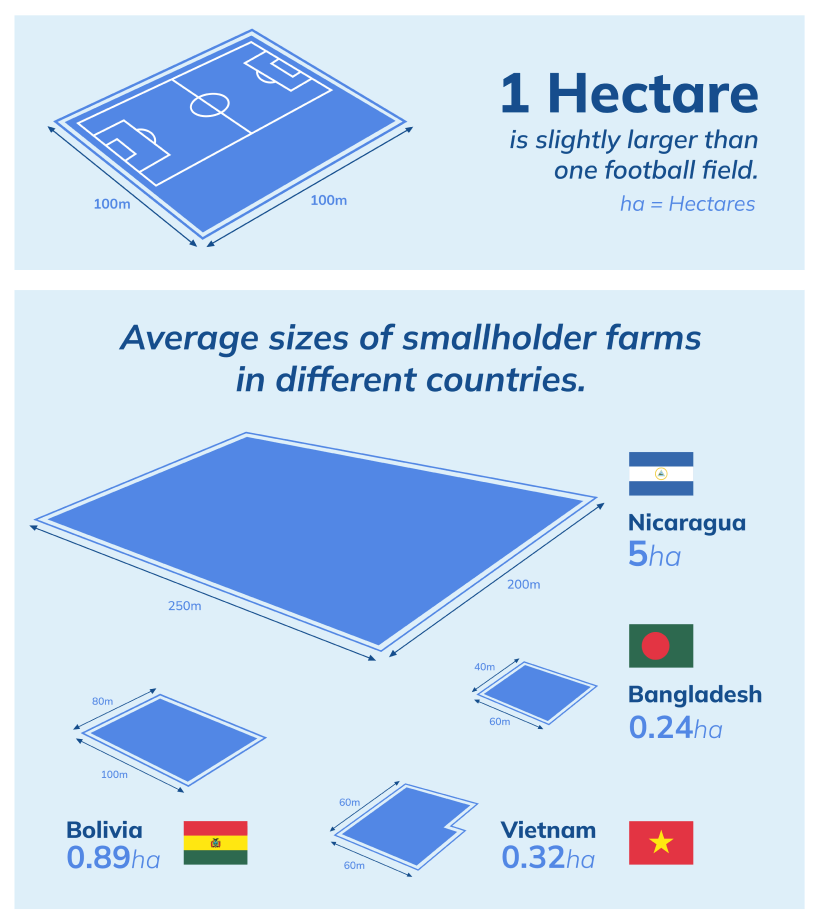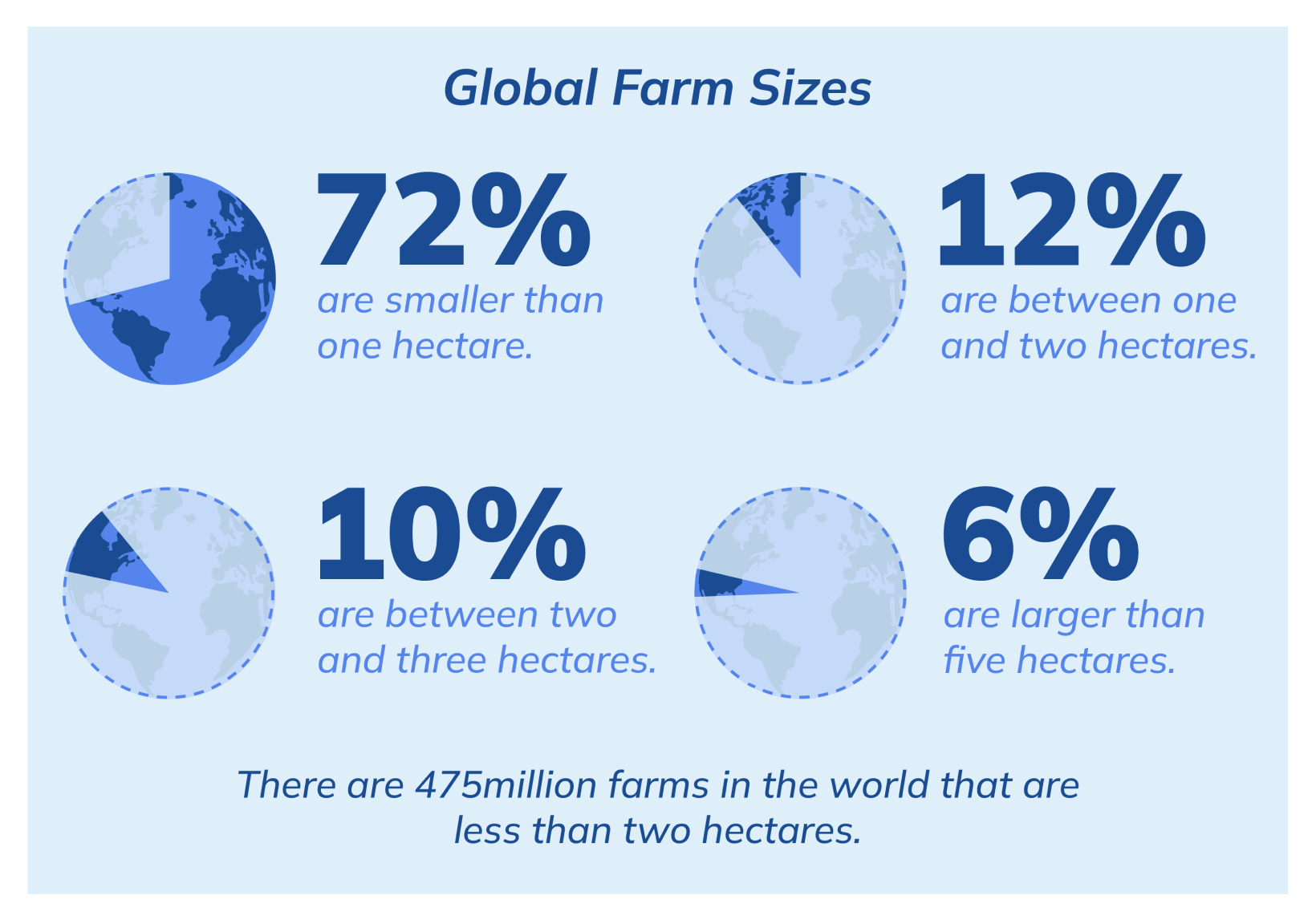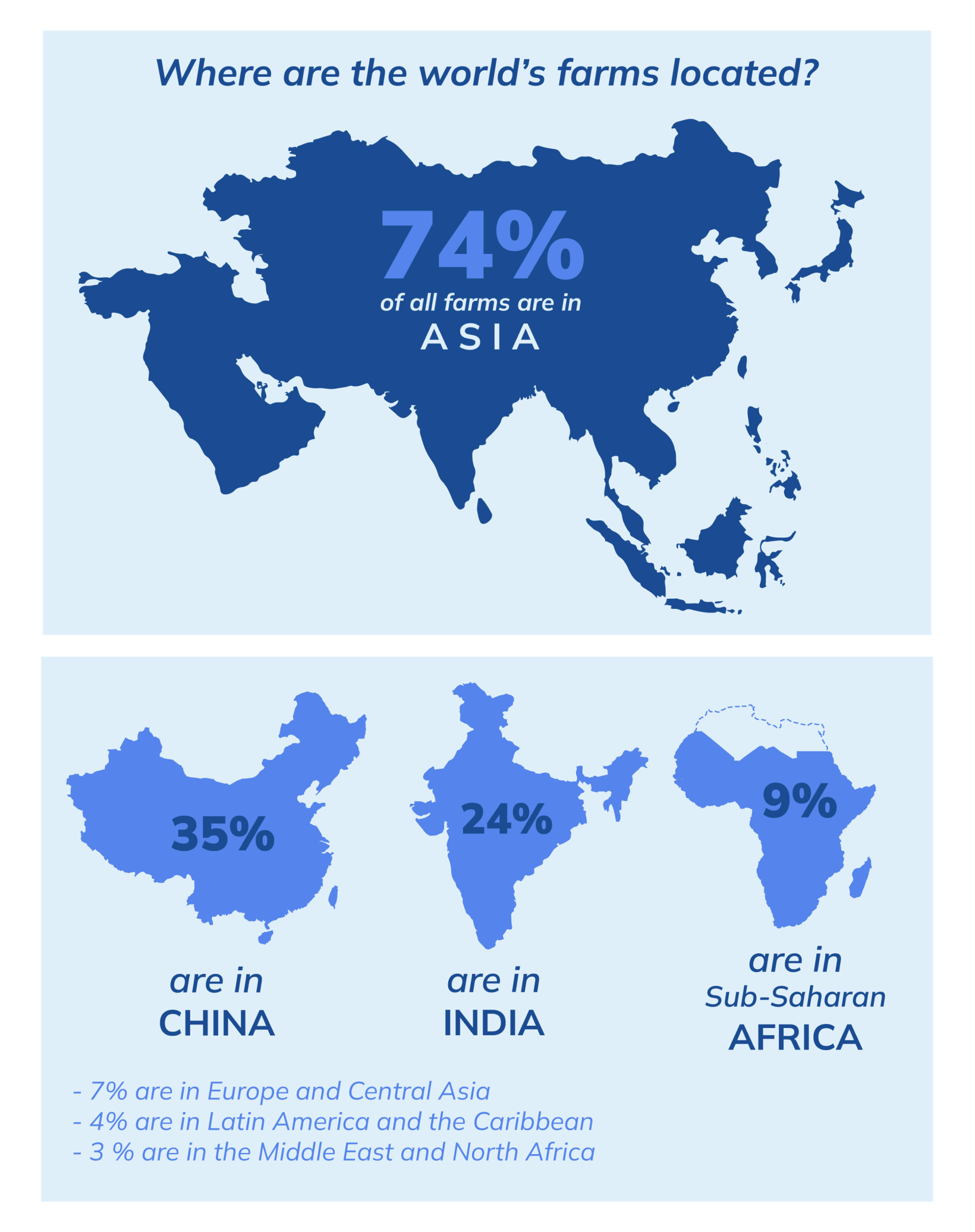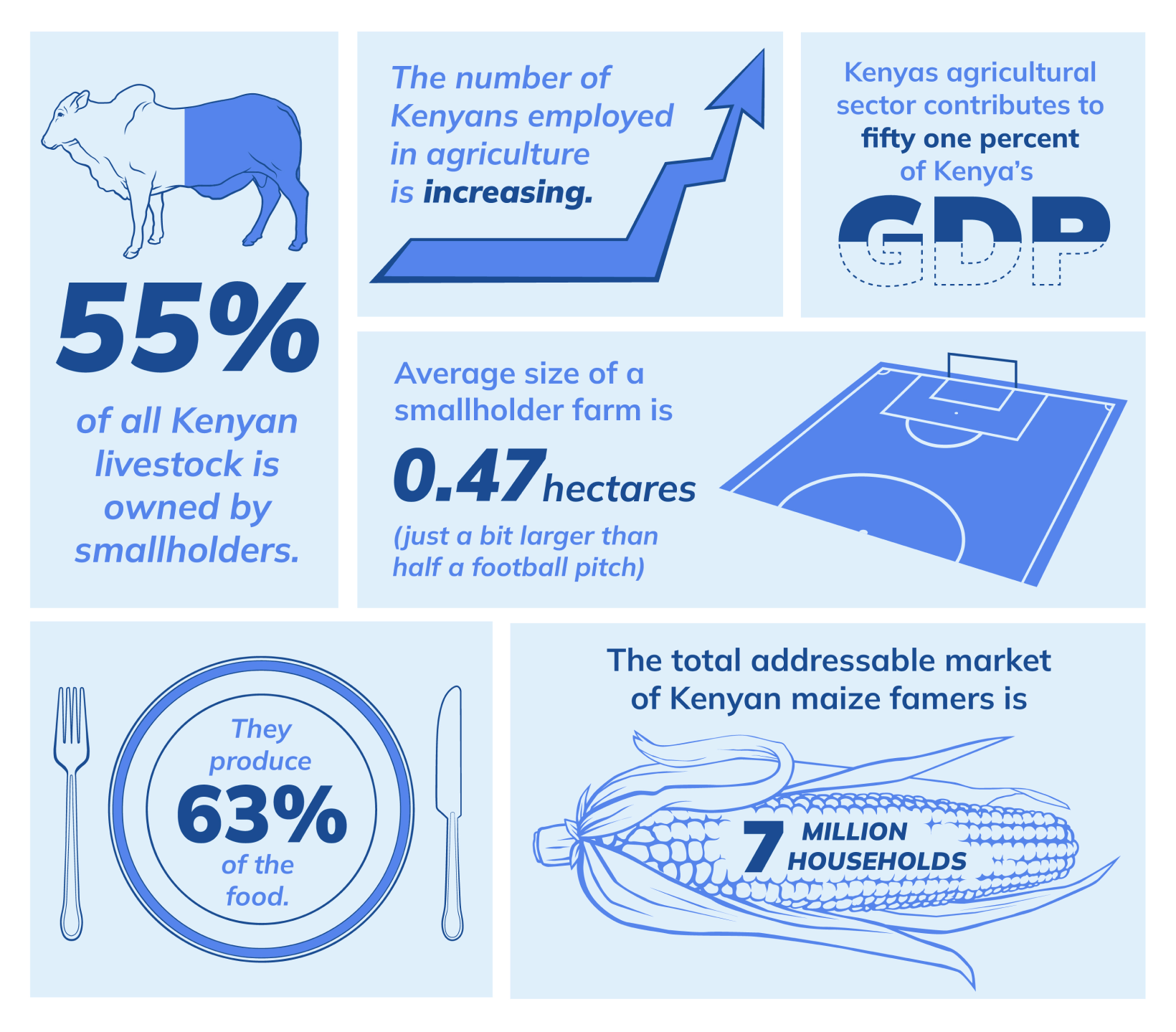How many smallholders
are there in the world?

Paul Baranowski
22 Nov 2021
8 min read
94%
of the world’s
farms are
smallholder farms
500mil
smallholder
farmers worldwide
80%
of Sub-Saharan
African farms are
< 2 hectare
Table of contents
- What is a smallholder farm?
- How many smallholders are in the world?
- How much land is farmed by smallholders?
- How much do smallholder produce?
- About Climate Edge
- References
Before estimating how many smallholders there are in the world we must first craft a precise definition of what exactly is meant by the term smallholding. This section explores the typical properties of smallholder agriculture, building a profile of the archetypal smallholder farmer.
If you're looking for a quick and easy definition of smallholding then we'd recommend using a rough threshold of <5ha (Lesiv et al., 2018) Otherwise, if you want to deepen your understanding of smallholder agriculture, read on!
While the size of a farm is clearly a necessary dimension of smallholder agriculture, it is not sufficient . A small farm in Brazil is ~50ha, move your focus to India and ~40% of farmers own less than 0.05ha. The term "small" therefore applies to more than just land assets. For example, a small plot growing high value crops with highly trained labour, substantial input usage, mechanisation and irrigation would not typically meet most people's concept of a smallholding.

A more rounded definition of a smallholder touches upon the concepts of:
-
Ownership
Smallholder farms are owned by individuals/families rather than businesses
This drastically changes the expenditure patterns of these farms. Social problems such as emergency healthcare crisis, are closely entwined with the outcome of the agricultural business as a whole
-
Labour
Smallholder farms rely on familial labour rather than paid workers
This reduces operational costs and also creates a more flexible approach where on-farm income can be complemented by off-farm work.
-
Asset/capital ownership
Going beyond land, smallholder farms have a low level of multiple classes of assets/capital. For example, a major advantage of large farms is the collateral which allows them to preferentially access financial products .
Smallholders lack these opportunities and therefore tend to have low investment in technology/usage, making up the gap with increased labour inputs
-
Agro-ecological zones
As you would expect, farms tend to be larger in drier agro-ecological zones, while wetter zones supporting multiple annual crop cycles can support smaller farm sizes. Defining a small farm should therefore take the zone into account.
It is worth noting that this trend is not always the case. In Ethiopia there are smaller farms in the drier highlands because of previous settlement histories
-
Livelihoods
Smallholder farmers have low profit margins which limit the owners ability to sustain a high quality livelihood. Smallholder farmers make up the largest demographic of people living on under $2 a day
Smallholder farms also tend to have a blend of commercial and subsistence crops compared to larger, more commercially focused farms.
These properties taken together result in a particular pattern/model of agriculture which is unique and distinct from that of larger farms. Based on these insights we can expand our previous definition to a more complete.
To see how specific countries define smallholders in their national click on the countries flag:

India: Small farms are <10ha
How many smallholders in the world?
Given the complexities in defining what a smallholder farm is, it is no surprise that estimating
the total number of smallholders worldwide is no easy task. There are many widely ranging
claims,
with authors highlighting the multiple caveats and assumptions inherent in their methodologies.
There have been two sophisticated and wide-ranging approaches taken to date. Lowder Skoet and
Raney Ricciari et al 2018 aggregated census data from individual countries to build up a
complete
picture. Alternatively, Lesiv et al., 2018 took an interesting approach using crowdsourcing
efforts
to outline field boundaries across a representative sample and calculating relative
distributions
from there. Fortunately, both approaches agree roughly on the number of farmers, differing on
the
degree of land ownership.
In total Lowder, Skoet and Raney (2016) estimated that there are 570 million farms in the world
of which 94% are smaller than 5 ha. They therefore estimate ~530 million smallholder farms in
the world with over 2bn individuals living on them.

How many smallholders in the world?
Smallholder farms are crucial for maintaining the global food supply and consequently can be
found throughout the world. However, the prevalence of smallholder agriculture differs
significantly between countries. There are many factors determining the average farm size of
a country, for example Jayne, Chamberlin and Headey, (2014) found that in regions where the
state actively supports smallholder agriculture, small farms become the norm. We will be
exploring
the key drivers of farm size in future articles. But today we are focusing on capturing a
current
snapshot of distribution and not asking why this came to be.
Looking at agriculture more generally, the world's farms are disproportionately found in
emerging markets, with China having nearly 200 million farms alone! Only 4% of the world's
farms are found in high income countries.
Zooming in on specific regions highlights just how prevalent smallholder agriculture is. Of
the 51.3m farms located in Sub-Saharan africa, over 80% (41 million) of them are less than 2
hectares . Current trends also indicate that farm sizes will continue to decline in Sub-Saharan
Africa for the next 30 years. In fact, by 2050 Africa will have as many rural people as in China
and Southeast Asia combined.

How much land is farmed by smallholders?
Despite their small size, smallholder farmers manage significant portions of the world's
agricultural land. Calculating exactly how much land is where the census approach starts to
diverge from crowdsourcing. Lowder estimates that small farms operate around 12% of the world's
farmland.
Lesiv put this figure substantially higher. Their crowdsourcing approach resulted in an
estimated 40% of the world's farmland being managed by smallholder farms.
Narrowing this focus on Sub-Saharan Africa increases this percentage. Around 80% of
sub-saharan farms are smaller than 2ha and operate ~40% of the regions farmland.
How much do smallholders produce?
Closely linked to the previous section is the question of how much smallholder farmers can
produce on the land they manage. Given the portion of land smallholders own, it is extremely
unlikely that the widely stated claim of 70% of all the world's food being produced by
smallholders
is correct. However, zooming into individual geographies and crops highlights the sheer
importance
of smallholder agriculture as the backbone of many food systems.
A more likely estimate is that farms <50ha produce 30% of the world's core food crops.
In areas where smallholder agriculture is the dominant model, production is even higher.
Small farms in Sub-Saharan Africa produce 51-77% of the regions food commodities.
Herreno et al 2017 have a fascinating article highlighting that it is also important to
look beyond simple yield metrics and focus on the underlying nutrient production.
For example, small farms produce 71% of the world's supply of vitamin A. More widely,
small-medium farms produce up to 77% of commodities and nutrients in sub-saharan africa.
It is also important to note that smallholder farms tend to be owned by poorer individuals
with a greater focus on subsistence crops. Therefore the crops produced on small farms also
have a hugely important role in maintaining livelihoods for an incredibly vulnerable
demographic.

About Climate Edge
If your organisation works in smallholder agriculture it is hugely important that you can
grow a deep understanding of the underlying trends and patterns shaping this industry.
The research highlighted above is a fantastic starting point, painting a broad brush picture
of smallholder agriculture. However, a common theme you may have noticed is just how variable
this sector is.
In order to make an impact you need a strong foundation of data on the specific farmers you
work with. By increasing last mile engagement, through accessible and affordable communication
channels - such as SMS, Climate Edge can help you connect with your farmers and build a detailed
understanding of their needs. To learn more about our services please get in contact "here"
References
Giller, K.E., Delaune, T., Silva, J.V., van Wijk, M., Hammond, J., Descheemaeker, K.,
van de Ven, G., Schut, A.G.T., Taulya, G., Chikowo, R. and Andersson, J.A. (2021).
Small farms and development in sub-Saharan Africa: Farming for food, for income or for
lack of better options? Food Security.
Herrero, M., Thornton, P.K., Power, B., Bogard, J.R., Remans, R., Fritz, S., Gerber, J.S.,
Nelson, G., See, L., Waha, K., Watson, R.A., West, P.C., Samberg, L.H., van de Steeg, J.,
Stephenson, E., van Wijk, M. and Havlík, P. (2017). Farming and the geography of nutrient
production for human use: a transdisciplinary analysis. The Lancet Planetary Health, 1(1),
pp.e33–e42.
Jayne, T.S., Chamberlin, J. and Headey, D.D. (2014). Land pressures, the evolution of
farming systems, and development strategies in Africa: A synthesis. Food Policy, 48, pp.1–17.
Lesiv, M., Laso Bayas, J.C., See, L., Duerauer, M., Dahlia, D., Durando, N., Hazarika, R.,
Kumar Sahariah, P., Vakolyuk, M., Blyshchyk, V., Bilous, A., Perez‐Hoyos, A., Gengler, S.,
Prestele, R., Bilous, S., Akhtar, I. ul H., Singha, K., Choudhury, S.B., Chetri, T. and Malek,
Ž. (2018). Estimating the global distribution of field size using crowdsourcing.
Global Change Biology, 25(1), pp.174–186.
Lowder, S.K., Skoet, J. and Raney, T. (2016). The Number, Size, and Distribution of Farms,
Smallholder Farms, and Family Farms Worldwide. World Development, [online] 87, pp.16–29.
Available at: https://www.sciencedirect.com/science/article/pii/S0305750X15002703
[Accessed 22 Oct. 2021].
Meyfroidt, P. (2017). Mapping farm size globally: benchmarking the smallholders debate.
Environmental Research Letters, 12(3), p.031002.
